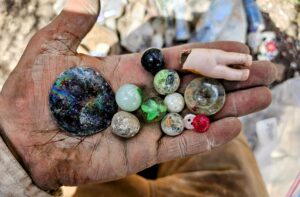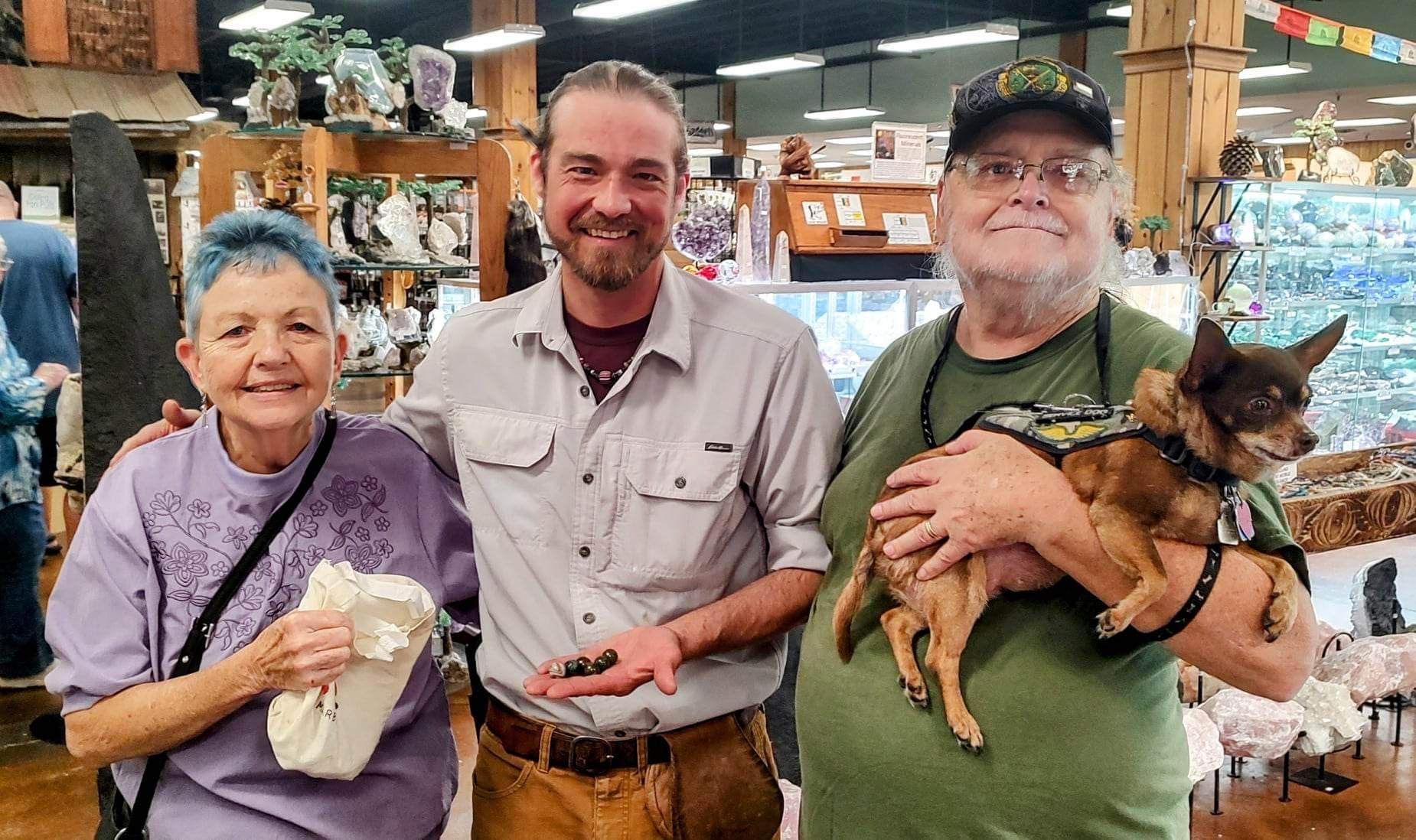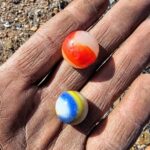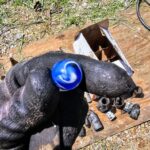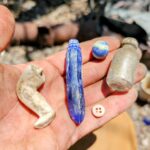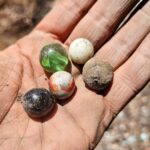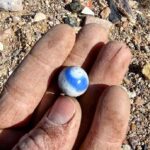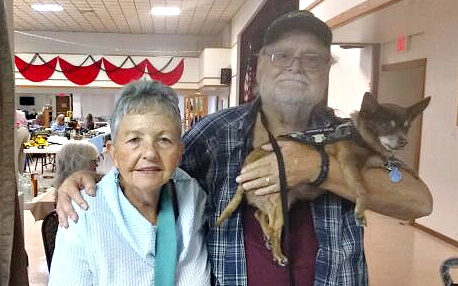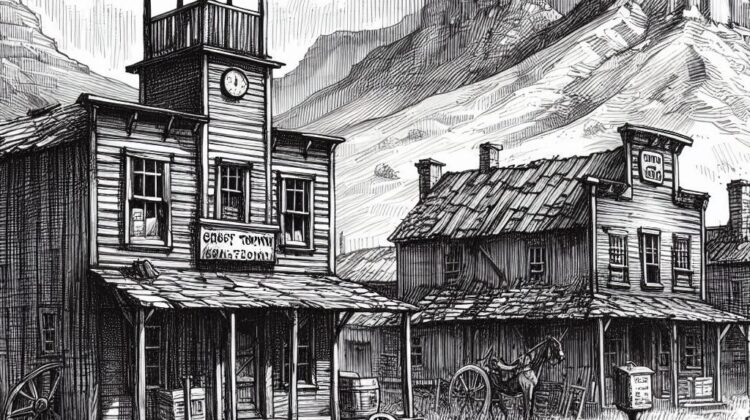
An Abandoned Western Town as Imagined by Microsoft Copilot
So, what is a ghost town? A ghost town is any historical town or site that leaves evidence of a town’s previous glory. This could be in many forms — all businesses closed, municipal services at a minimum, rubble and old nails strewn about, ruins of former buildings, etc. However, some places categorized as ghost towns still have people living in them. Though sometimes they don’t want to be called ghost towns, most historians will continue to reference them that way if the reason or purpose for their original “boom” is gone[1].
Glory Days[2]
Glory days and booms times take many forms. The boom times include a period of rapid growth and prosperity for most of the people in the community. During this time if a person is not sharing in the wealth and the glory then she or he will likely move on if moving is a possibility.
Houses, saloons, churches, and schools are built quickly and all too often they are shoddily built. We have all read or seen in films how many boom towns burned and then were built back using brick.
The population shoots up during booms when people are working. Two things are always intertwined: fortune and opportunity. Risks are very high but sometimes the payout matches the brutally hard work. But all too often there is heartache and disappointment at the end of the line[3].
Still soon, if the town could hang on long enough, the post office will open and townsfolk will turn to building theater and opera houses. Culture and comfort are considered will worth the costs. All sorts of entertainment are available almost from the very start.

“The Slave of Gold” Library of Congress Prints and Photographs Division Washington, D.C[5].
“Drinks 12 ½ Cts.”
In her online article “What Were Wild West Saloons Really Like?” Melissa Santore[4] answers this question for us and her answers are fascinating. For example: “The activities that took place at saloons were emblematic of the American West itself; just as settlers gambled everything to embark into the unknown, saloon patrons could bet their earnings on a friendly game of faro[6] or poker. Saloons provided a means of survival, even offering a chance at wealth and prosperity on the frontier.”
And “as one of the first establishments to pop up in a frontier settlement, saloons served a variety of functions. They were gathering sites for drinking, socializing, and relaxing, and they often became the focal point of an entire camp or town.”
As examples consider that Dodge City, Kansas at its peak had over 20 saloons. Virginia City, Nevada, which mined tons of silver, had over 100 saloons at its peak[7].
Diggin’ Holes
Often the main livelihood in boom towns came from the extraction industry: coal, gold, silver, copper, lead, zinc, and gemstones. Oil also accounts for its share of boom towns. With all of the Western towns’ activities hinged on one or two types of production life could be very uncertain.
For one thing, the natural resources, such as timber, may be exhausted. Or federal government policy may change the demand for silver or gold, for example, and in this case millions of dollars in resources may be left in the ground. There could be a market crash—for example for copper or oil.
Fires, floods, and all too common droughts may simply make it too expensive for speculators to remain. Badly needed railroads or roads may bypass the town making it tricky or too expensive to ship their product. And, finally, the community may just become too violent, corrupt, and lawless, and remote for new settlement and for new capital investment.
Courtesy of Chase Pipes and Brett Stinnett
Can A Ghost Town Possibly Have Toy Marbles?
Yes, they can and they do! Even considering all that we have said about ghost towns, children were present in the “wild west” and ghost towns wherever they are found. In fact, schools were one of the first structures built in these communities—right after a few saloons went up! And where you find children you find children’s toys. The photo above shows toys typical of a western ghost town dig.
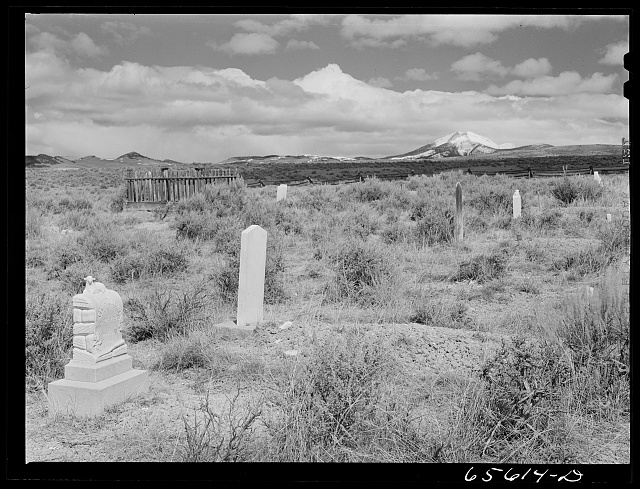
Bannack, Montana. Graveyard[8]
We take you to a ghost town cemetery to help prove our point. Look at this photograph closely. It epitomizes the remoteness of the area and you can almost feel just how lonely some of these places were in the 19th century[9]. And there is a lamb[10] atop the gravestone in the lower left. A child lies resting there. But where are the baby’s parents’ graves? Often children are buried between their parents. Did the town’s bust happen and the parents move away?
Regardless of how remote, how violent, and how unstable life in the camps, towns, and communities there were children there. They studied in one room school houses, often lived near the mines, and they played with homemade games, as well as with store-bought toys and marbles!
Finding Marbles In Ghost Towns
What we have said about ghost towns in the old West echoes abandoned towns in the East—from Cahaba in Dallas County, Alabama, to Hanton City near Smithfield in Rhode Island. And yet today people do gain permission and then discover marbles among the many other artifacts both on the surface and dug in the midst of the ghost town.
There are two types of searchers who find marbles in ghost towns: well-informed non-professionals and archaeologists, anthropologists, and other professionals often associated with a university or a museum[11].
Chase Pipes
Chase is an excellent example of the first type searcher: the well informed non-professional.
Photograph by Larry’s Sister Lynn G. Howell
We Visit Chase in The Relic Room
Chase has spent his life in Dandridge, Tennessee’s second oldest town, and in Sevierville, Tennessee. The two towns are only about 20 miles apart. Chase has a number of sites online, and one of the best stories that we have found is the “Want to take home dinosaur bones and Moon rocks? This one-stop shop in Tennessee has it all” by Jennifer Markert[12].
Chase is co-owner and operator of The Relic Room in Seveirville. “Tucked inside Smoky Mountain Knife Works, ‘the world’s largest knife showplace,’ the Relic Room is one department of the store where every bit of history on display is for sale.”
He also has his own YouTube channel and local radio show[13], both of which have the title Chasing History. We have featured Chase in two of our stories: “You Dug It Up Where?” ; and in “Marbles in The Mountains 2023” [14].
Fossil Wyoming
We have viewed and enjoyed a number of Chase’s videos and at least one, “Exploring The Ghost Town of Fossil Wyoming[15]” speaks directly to our major ideas in this story. In the YouTube video Chase shows exactly how to search a ghost town for artifacts in the proper and respectful way.
This is an extremely interesting video and Chase can’t contain his excitement, which is contagious, as he discovers artifact after artifact. He and others explore old privies, root cellars, a barn, a log cabin made from railroad ties, and, most interesting of all to us, he searches under the floorboards of the old town depot.
He teaches us a great deal about how to approach any such search in a practiced and informed manner. He explains early on that water was an issue in the town of Fossil because it was so hard[16]. The lack of clean drinking water was a problem in many ghost towns and not only in the West.
Paul Kester & The Fossil Basin Institute
Paul Kester is the president of the Fossil Basin Institute and he is in charge of the reconstruction of some of the historic buildings in the old town of Fossil. However, as Chase shows us, some structures are far too deteriorated to restore. But the depot does remain, and it is being restored to provide a museum for artifacts which Chase and others find and have found on the site.
Paul explains that the Fossil Basin Institute was started in 2010 when four individuals decided the depot would be ideal “for a Science Institute so we expanded it to include not only scientific study but also cultural history of this part of Lincoln County here in Wyoming.” [Emphasis added.
He believes that the ghost town is an excellent site for University field schools and he tells Chase that we “already have three universities that have expressed interest to hold summer classes out here when this is done” … and we will put on periodic classes for the community on Natural History, Science …and whatever they’re interested in. We’re going to convert the depot here into a classroom.”
The old freight room, under which Chase searched with a metal detector and found and retrieved a fantastic old cask, and perhaps the old depot waiting room will be a “…museum featuring artifacts from the old town of Fossil. Some of the stuff that we’re here collecting today…and we have several things already that we have just waiting to get it finished so we can get it open.” And yes, Chase and friends do dig up marbles in Fossil in a couple of different places!
We hope that the marbles will take their rightful place in the museum along with the cask and other found artifacts.
Children’s Contribution To Culture
Chase notes “ that’s so cool that you’re incorporating a historic building [in a ghost town] and giving it a modern use by allowing universities to come up here and to establish schools and to learn more … [about] the fossil history in this area….[17]”
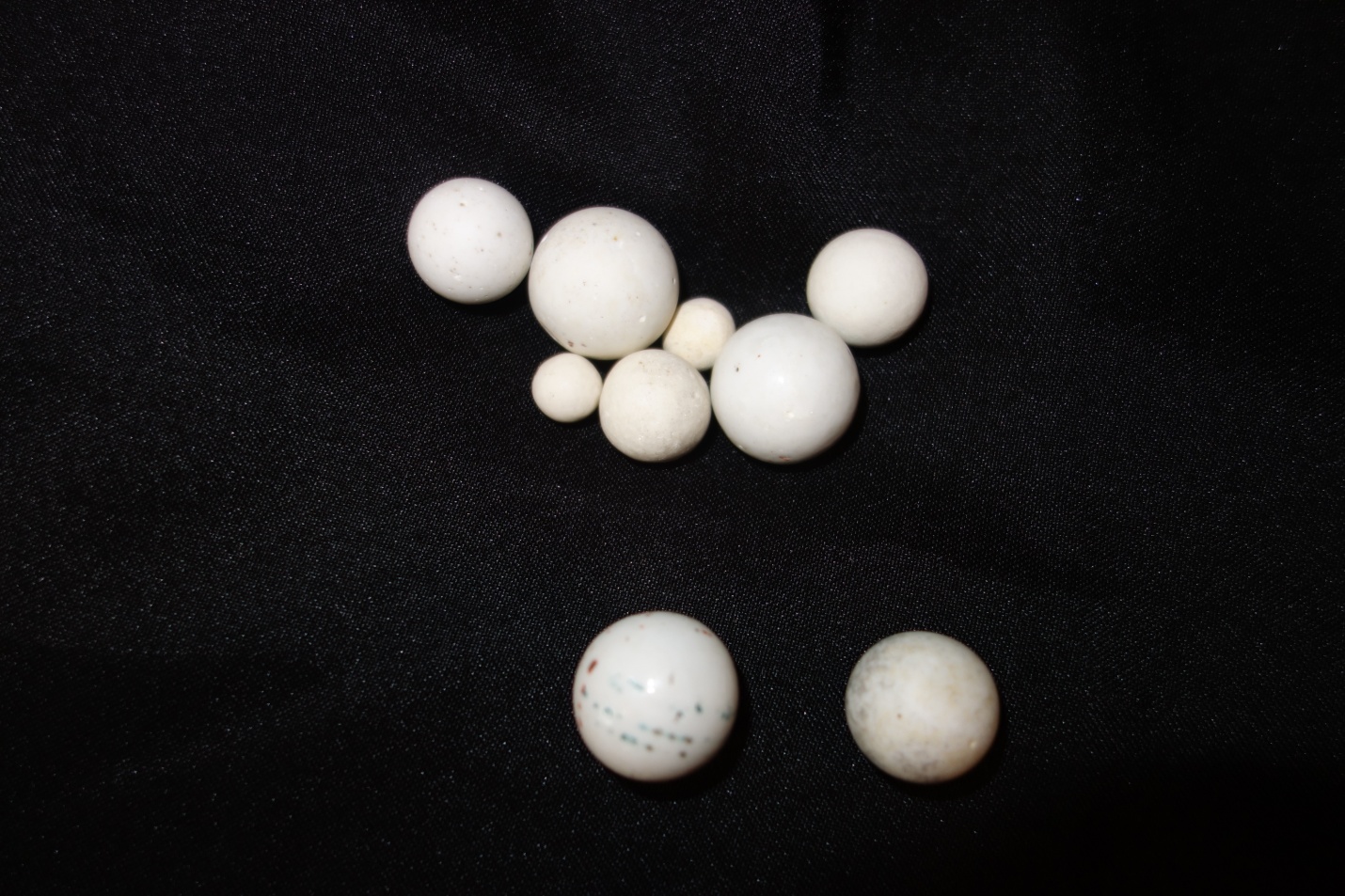 Types of marbles often found in ghost towns: Stone, Clay, & Decorated & Glazed China
Types of marbles often found in ghost towns: Stone, Clay, & Decorated & Glazed China
Photograph by Jo Garrett
We recommend that you watch this video and others that Chase has posted online. We can think of no better way to explore towns than with the landowners’ permission, and hopefully, a place like a museum or institute which would incorporate found marbles into their displays. Children’s material culture is as important to place history and to culture as is the adults’. Below Chase displays evidence of this culture.
Professional Hole Diggers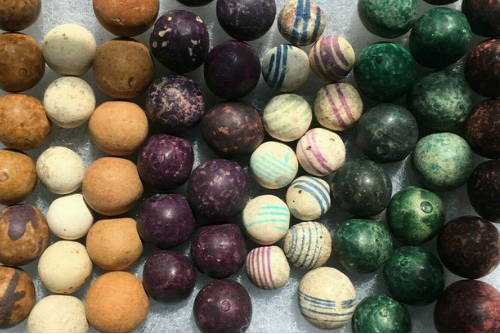
Courtesy of San Diego Archaeological Center
Staff at the San Diego Archaeological Center (San Diego Archaeological Center – SAN DIEGO ARCHAEOLOGICAL CENTER) is an excellent example of professionals at work recovering and preserving artifacts for future generation to enjoy and to learn from. The Center and Museum are in the San Pasqual Valley in Escondido, California. It is “a nonprofit museum where visitors can learn the story of how people have lived in San Diego County for the past 12,000 years. Founded in 1993, the Center was the first private nonprofit dedicated to the care, management, and use of archaeological collections.”
The photograph of historical marbles is from Scottie Loyd’s story “Historic Toy Marbles.[18]” Loyd writes that “the types of marbles found in San Diego Archaeological Center’s collections span from the transformative period of clay and stone-based marbles to glass marbles. This project reviews six non-glass and five glass basic marble types to help familiarize students and researchers with marbles found locally in Southern California.”
Public Archaeology
Public Archaeology is defined by the Society for American Archaeology (https://www.saa.org/education-outreach/public-outreach/what-is-public-archaeology) as being “all about engaging the public in archaeological research and heritage preservation.” “…it has evolved to include activities like lectures, interpretive signs, and site tours.[19]”
And San Diego Archaeological Center, which has been hard at work for some twenty years, is a fantastic example of public archaeology in action. They offer Internships in public archaeology, collections management, Photogrammetry[20], and so much more. Volunteers work as museum docents, in the youth education, and, again much more.
We don’t know if you have opportunities like this, or have ever taken advantage of such programs in the area where you live, but we have and we cannot recommend any opportunity more highly if you are interested in history, artifact preservation, accessions, and just plain old grubbing in the dirt! Such volunteer work can be an absolutely transformative experience!
Jamestowne, Virginia
Jamestowne, founded in 1607[21], was the first permanent English settlement in North America. It is not now nor has it ever been a “traditional” ghost town like the ones we have explored out West and the others that we have mentioned in the East. But the original town is no longer there. It has long since surrendered to natural decay, and like so many towns in the West, to fires. Finally the relocation of the capital to Williamsburg, Virginia, in 1699 was the death knell for Jamestown.
The site of the original Jamestowne is in James City County, Virginia, which also includes Williamsburg, and the County is bustling and alive!
We believe there are a number of reasons to include Jamestown in this story. For example there are the town residents’ early privations. Some of these hardships are very much like all ghost towns suffered at some time in their life.
However, some of the history of James Fort is unique. The harsh and brutal winter of 1609 – 1610, for example, is often called the “starving time.” There were 300 settlers at the start of winter while about 60 survived. At this time colonists in James Fort resorted to eating horses, snakes, rats, cats, dogs, and shoe leather (https://historicjamestowne.org/history/jamestown-timeline/). Tragically some of the Fort’s residents resorted to cannibalism[22].
Jamestown, like most western abandoned towns, also suffered conflicts with the Native Americans (the Anglo-Powatan War). In 1622, 347 colonists were killed up and down the James River. The conflicts were long and often brutal for both the colonists and the Native Virginians.
The weather, like in many other ghost towns, was often devastating. Hurricanes were always a threat during hurricane season. Needless to say, there were diseases. Finally, there was political uncertainty both within the town and with the Virginia Company.
Historic Jamestowne & Preservation Virginia
There is renewed life at Jamestown today! The site is now known as HiHistoricHistoric JahisHistoric Jamestowne. “The Association for the Preservation of Virginia Antiquities (APVA: now Preservation Virginia) acquired 22.5 acres on Jamestown Island in 1893 to protect the memory of America’s birthplace. In 1994, the APVA began an archaeological project called Jamestown Rediscovery to find the remains of the original James Fort, ca. 1607–1624. Over 25 years of exploration have established the location of the fort and principal buildings and recovered more than three million artifacts… [Emphasis added] These discoveries, along with countless artifacts, provide a window into early colonial life, allowing historians and visitors to piece together the story of the first permanent English settlement in North America .” The Project continues today.
Jamestown Settlement
There is even more to see than the archaeology at Jamestown! Check the “Map of Discoveries” site at Jamestown Rediscovery (Map of Discoveries | Historic Jamestowne).
There are nearby interpretive centers and living-history museums, such as the Jamestown Settlement. Reconstructed exhibits are designed to help visitors understand the layout and daily life of the original town.
No, you cannot see the original James Fort or town, but history is still very much alive in Jamestown! On the weekends you and your family can see re-enactors working in historic trades like blacksmithing, woodworking, and much more[23]. Both the spirit and the history of the old town are carefully and skillfully preserved and curated for public information and remembrance. We can think of no more fun family learning experience than Jamestown for those interested in history.
And trust us on this: living history can be tremendously exciting and authentic! We will always remember being “shot” unexpectedly by a Confederate sentry just outside Fort Gaines on Dauphin Island, Alabama. And we can still visualize those Seminole warriors who tore out of the bayonet palmetto and scrub pine and into Major Francis Langhorne Dade’s Companies at Dade’s Battle Reenactment in Dade City, Florida!
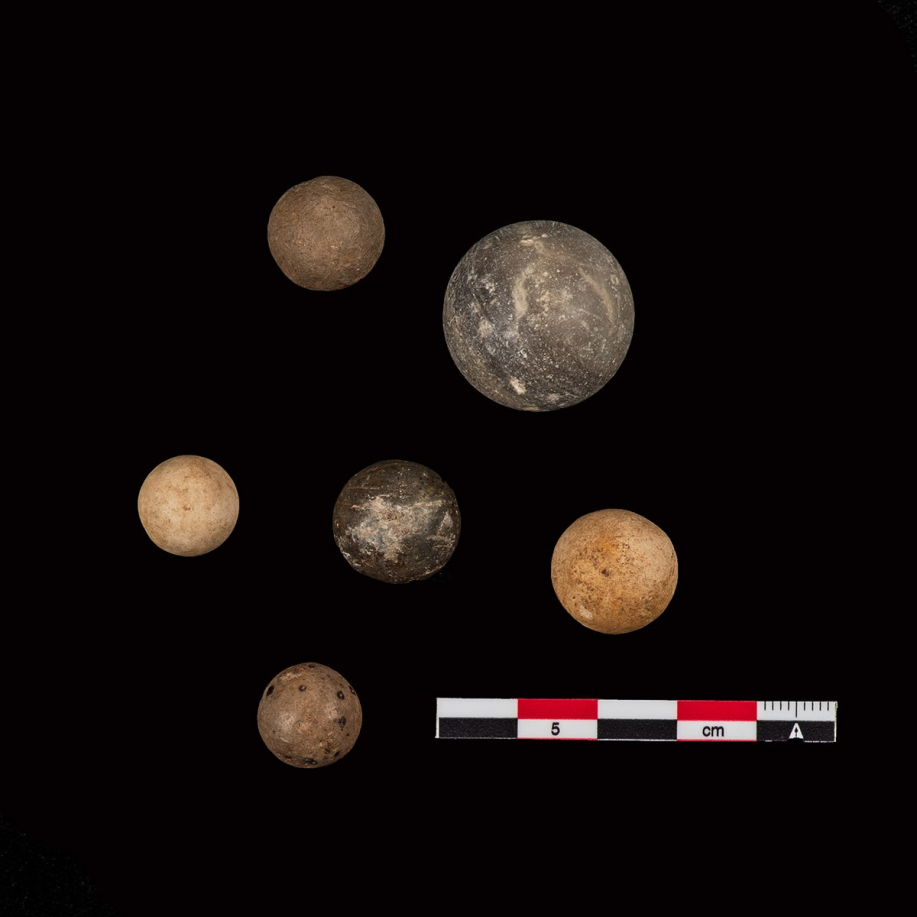
Jamestown Rediscovery (Preservation Virginia)[24] Historic Jamestowne – Preservation Virginia
Were Marbles Ever Found or Dug in Jamestown?
Yes.
Just check out these mid-17th – 20th century ceramic and stone marbles in the photo above. And check out the story “Marbles at Jamestown Rediscovery Historic Jamestown.”
The Archaearium
There is a special museum in Historic Jamestowne where artifacts found on the site are kept, archived, accessioned and displayed for those visiting Colonial National Historical Park[25]. This is the Archaearium and Dr. Jamie May is Director.
You can explore the museum as part of your admission to the Jamestown site, and the exhibits are updated periodically to reflect new archaeological discoveries. It is an “award-winning archaeology museum that showcases over 4,000 artifacts recovered from the James Fort site. These artifacts, dating back to the early 1600s, provide a fascinating glimpse into the lives of the first English settlers in America and their interactions with the Virginia Indians.” (Jamestown Rediscovery (Preservation Virginia)
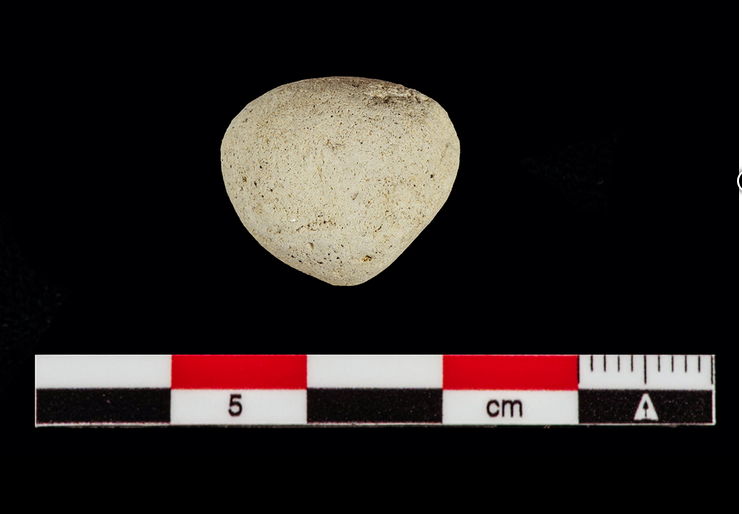
Jamestown Marbles – Possibly Locally Made
We learned a lot from the “Marbles story…” mentioned above. First: a total of 25 complete and fragmentary marbles have been recovered at Jamestown by archaeologists.
It was refreshing to us that we are not the only ones who save and treasure “wounded” marbles and even fragments of marbles! Microsoft Copilot explains that the usage of the word “wounded” is largely subjective within the collector community. One seller’s “wounded” marble might be another’s charming imperfection, and there isn’t a universally codified definition for the term in the same way that some other collectible categories have standardized grading.
We have had many a discussion while hunting marbles about whether or not a curved marble glass sliver was enough to keep! And for us every marble flea and ding, even a manufacturing blowout, has a story to tell. Frankly, we aren’t positive that this odd locally made clay marble is “wounded”, but it is certainly odd. We are surprised that the archaeologist who found it kept it as a marble and a toy.
The second thing that really caught our attention in the story is the fact that archaeologists on site do keep modern marbles as well as unusual and much older ones.
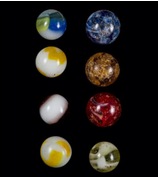
Jamestown Rediscovery (Preservation Virginia)
Glass Marbles
What we found most amazing is that archaeologists saved not only the very old 17th century marbles, but the modern glass ones as well! There are some very nice glass marbles on the right-hand side of the image.
Both in our book The Secret Life of Marbles Their History and Mystery and in our eZine story “Invisible Children” we document and lament the fact that for centuries archaeologists and academics simply ignored children, children’s health, and the social-cultural contributions which children could make to the archaeological records. It was not as if children were lost in the archaeological records—they never existed.
Well, historic Jamestown certainly does not dismiss or overlook children! In fact, the archaeologists and historians there are more attuned to children’s contributions than those at any other site that we have investigated.
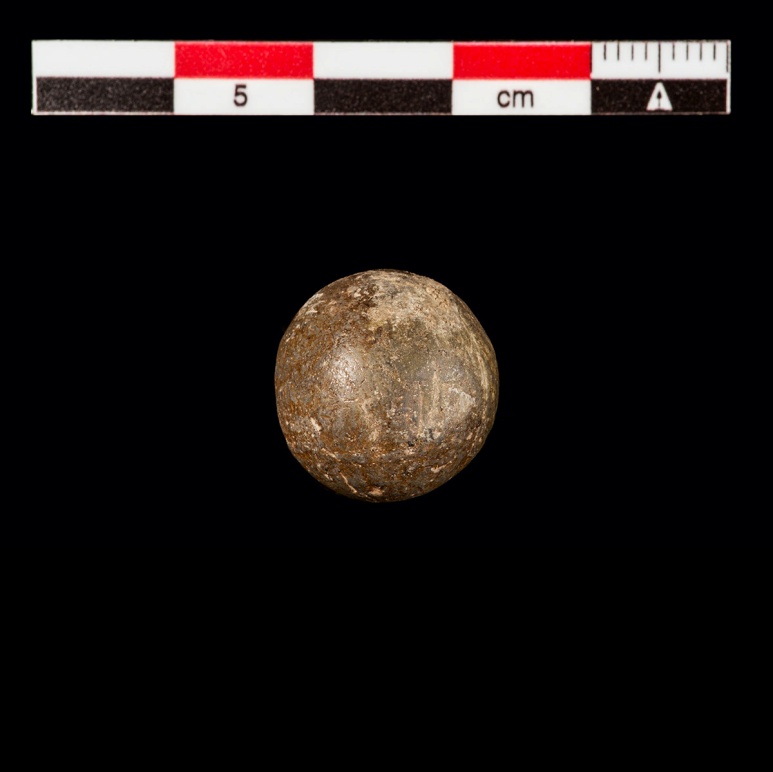 Brown Salt-glazed Stoneware Marble
Brown Salt-glazed Stoneware Marble
Jamestown Rediscovery (Preservation Virginia)
Brown Salt-glazed Stoneware Marble
This brown salt-glazed stoneware marble is one of five ceramics found. Of course, the odd and marble above is also clay-ceramic and it was possibly made by one of the colonists.
This salt-glazed is “the most common type of marble used in the 17th century.” This one was dug from a mid-17th century (1600 – 1800) feature at Jamestown. We are uncertain in which feature it was found but we imagine that it was a home. “This is the earliest datable marble in the Jamestown collection. It and the one other stoneware marble in the collection may have been produced in Germany, the Netherlands, or England before arriving in Virginia. By the late 18th century, earthenware marbles were produced on a small scale in America….”

Ceramic, bisque Stoneware Marble
Jamestown Rediscovery (Preservation Virginia)
Bisque
While we have found hundreds of different kinds of marbles in the rough, we would never have been able to identify this 17th century unglazed stoneware marble. It is very interesting with its unusual “spots” of darker brown.
Bisque marbles are unglazed stoneware which are fired at a high enough temperature that they are impermeable to liquids. Unlike the Jamestown find, they are often gray in color and they often do have these small orange inclusions. We have no idea what these inclusions are and why bisque marbles sometimes have them[26].
By definition an inclusion in clay refers to any foreign material that becomes embedded within the clay matrix. They can occur naturally—such as fragments of minerals, organic matter, or other particles originally present in the raw clay deposit—or they can be intentionally added during the preparation of the clay body[27] .
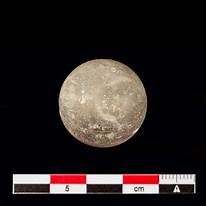
Stone Marble
Jamestown Rediscovery (Preservation Virginia)
Stone
Before the late 17th century marbles found on American Colonial sites were almost exclusively ceramic to include, of course, handmade or primitive clay.
We learned from the Jamestown site that stone marbles were not made commercially until the 1680s. “In the 18th century, stone marbles began to replace ceramic ones and by the early 19th century, more stone marbles are found on American sites than ceramic marbles. Only two marbles in the Jamestown collection are made of stone, and they are most likely from the 18th-19th century when these marbles were at their most popular.[28]”
Only One Marble
We have often read about prohibitions against marbles and marble playing. If there were no statutes against it then there were certainly family rules against it. Some parents relented and allowed marble play but only for fun and never for keeps. Another well-known family rule was never play marbles on Sunday. Period.
Well in the Jamestown story we gained even more insight into this subject:
“Seventeenth century historical documents indicate that marbles were both a popular and controversial game. Beginning as early as the medieval period and continuing into the 1600’s, laws prohibited playing with marbles and other games both in Europe and the colonies.
Similar laws were passed in New York in 1679 and in Pennsylvania in 1705. These laws may be the reason why marbles are found in much lower quantities in English 17th century colonial sites than they are in Dutch and French sites. Even if no prohibitions against marbles specifically existed in the earliest days of Jamestown, there was likely disapproval of these games”.
The Laws Divine, Morall, and Martiall, adopted in 1610-12 indicate that individuals were not to
“use any unlawfull and prohibited games… However, archaeological evidence in the Jamestown collection suggests that these prohibitions did not stop at least one marble from appearing in Virginia by the mid-17th century.[29]”
Well, What Do You Think Now?
We hope that you have enjoyed reading about ghost towns and ghost town marbles in this story. We learned a lot while researching and writing it. If you enjoyed it, we recommend one 872 page book that describes well known and unknown ghost towns from Alaska and British Columbia and to Arizona: Ghost Towns of the West, A Promotory Press Book, Superior Publishing Company, 1971. It includes drawings and black and white photos.
Our theme in this story, as always, is the consideration of the roles marbles played throughout history and across cultures. Frankly, when we look at western ghost towns and consider their often violent and always hardscrabble life, and when we consider how terribly difficult hard rock mining was to do with pick and shovel, we are surprised that there were children in some of the communities. We can’t imagine how fathers had any energy left for a wife and children!
We also have to point out that it was often a long way to medical help when needed and even if you could get to a doctor medical knowledge was limited. Smallpox, cholera, typhoid and yellow fevers all took a heavy toll.
Children died of the croup and scarlet fever in addition to all the other diseases which were all too often attributed to the poor sanitation of the towns.
Jamestown in Virginia is no exception—times there were as hard as life can possibly get. And yet marbles have been found there which date back to the 17th century.I
Children lived and played in what today are ghost towns—they were a part of the life and pulse of what is today a lonely ghost town. And they left evidence behind in the form of little round marbles.
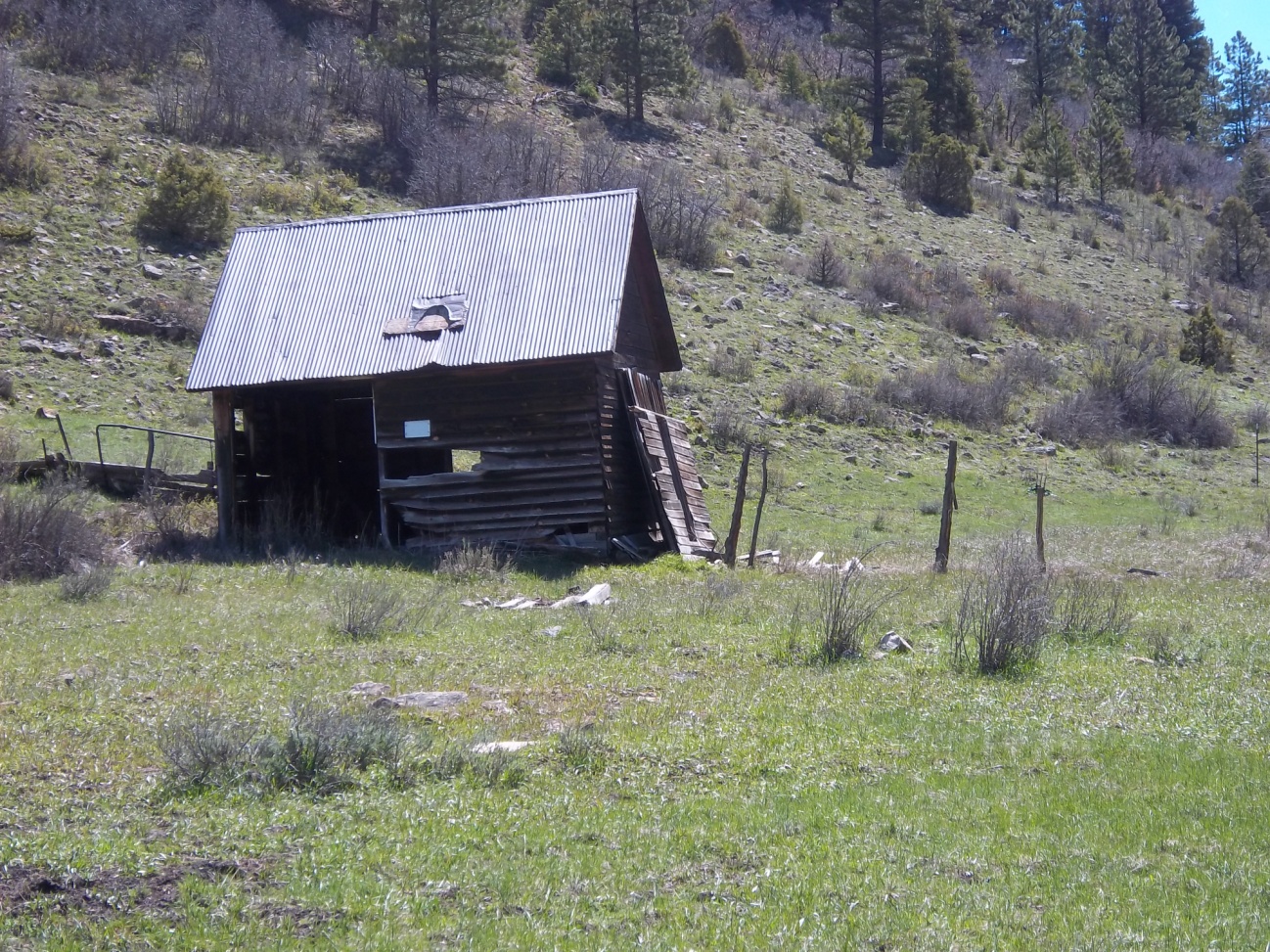
Photograph by Jo Garrett
We close this story with a special afterword. If you are ever exploring we recommend that you follow these guidelines.Happy exploring!
An Explorers Code of Ethics
Be Careful & Behave
It may not be a ghost town. Upon your arrival you may look around and believe that you are at the far end of nowhere and are all alone with your exploring friends. You may be. Some time ago while driving along the North Carolina Coast we stopped for gas in Stumpy Point.
The man at the store called out “Welcome to the end of the world!” This unincorporated community sits on a point which looks like a downward pointing thumb sticking into Stumpy Point Bay near the Alligator River. The Stumpy Point resident was speaking literally: the “world,” land, and earth do end in the Ocean in the town! On the other hand, people do still live and thrive in the community.
Thurmond, in Fayette County, West Virginia, is another example of a ghost town with inhabitants. The community is on the New River and while settled in 1844, it was not incorporated until 1900. Thurmond’s glory was coal. It was a well-to-do coal and railroad town in its day and it is not empty. The 2020 census counted five people who lived there and today there may be seven!
Another ghost town is Kerr City in the Ocala National Forest, Marion County, Florida. At one time 100 people lived there while today the lone caretaker is the only person in town. Kerr City’s glory was oranges and then tourists. The post office is still standing and once there was a general store, a three story hotel, a sawmill and other businesses. Today the town is closed to the public, but we used to visit with the caretaker every time we camped in the nearby Salt Springs.
The BLM
You may find a ghost town well out in what you are positive are the “boonies” and it may appear to be completely devoid of life. While it may be, it may also be one of the ghost towns, like Garnet[30], Montana, which is overseen by The Bureau of Land Management ( BLM) in the United States Interior Department. The BLM oversees 247.3 million acres of land across the United States, primarily in twelve western [31] states. However, the BLM does not directly govern towns—it manages public lands for multiple uses, including conservation, recreation, and resource development.
Someone may actually live there[32]. In fact a BLM employee may live in town or very nearby. We have often been astounded when we thought we were all alone in a lonely place, sometimes for a while, only to learn that someone is very close by.
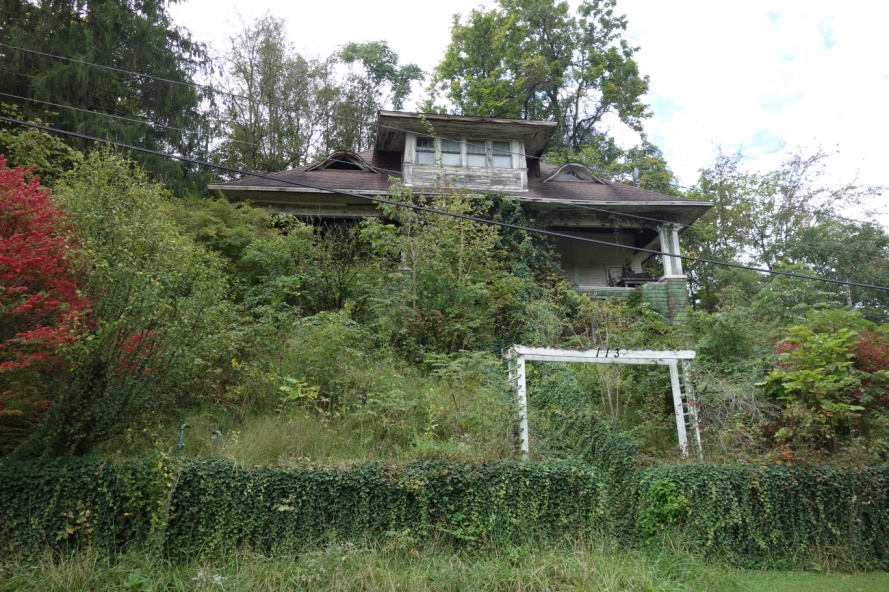
Photograph by Jo Garrett
Arrested Decay
Ever heard of the idea of arrested decay? Neither had we until we were researching this story. This is what the BLM says about it when referencing Garnet:
“That means that although visitors can walk through the buildings — even venturing into the second and third floor of the J.K. Wells Hotel — the interiors have not been restored to an idealized version of the past…some walls are covered in multiple layers of peeling wallpaper; char is visible on the roof of the former blacksmith shop; and assorted detritus like metal mattresses, rusty beer cans and an old sewing machine occupies rooms, much as it might have when it was first left behind.
‘We’re maintaining them in a state of as is so the people can step back in time and see the way the buildings were and how [the structures have] kind of weathered a little bit…. It’s a hard balance because arrested decay — you are just managing for what is there but yet you don’t want things to weather too much’”.
We have walked into an 1870’s post office/general store that was very eerie because you felt like you could just walk up to the counter and get your mail. Back then there was no need to tell anyone your name because everyone already knew you: or at least knew which family you belonged to. And if you got a penny post card in the mail then it had already been read and gossiped around the community.
But tread carefully in an old saloon when there are still antique cards on the table and old bottles of booze behind the bar. There may well be a reason for both.
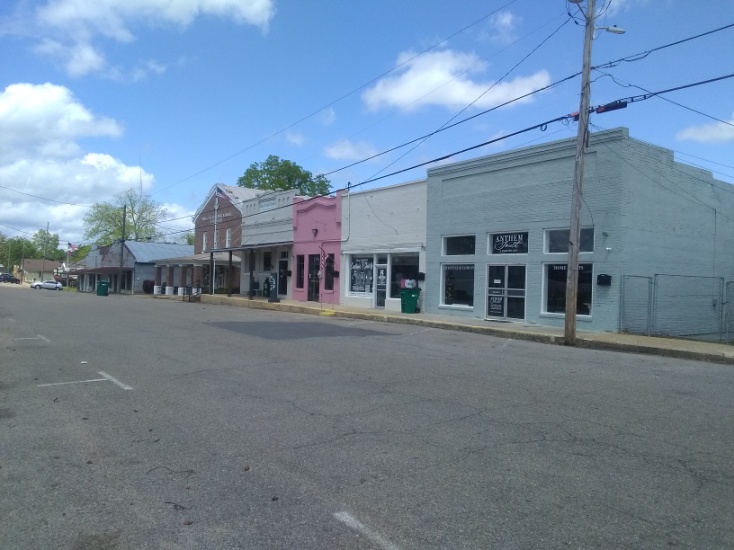
Ghost Town or Not Yet?
Photograph by Jo Garrett
Ethics and Appropriate Behavior
We were astounded to learn when we wrote a chapter in our book The Secret Life of Marbles that visitors were prone to steal moqui marbles from Grand Staircase-Escalante National Monument in Utah. Not one. Not two. Truckloads to sell at flea markets and antique shops.
People have defaced pictographs and the damage, for example at Utah’s 2,500 old Birthing Rock, which was defaced with racist phrases and obscene graffiti, is irreparable. And indefensible. Other damage at Big Bend National Park and ghost towns all across America is just heartbreaking[33].
So, yes there is a ghost town code of ethics. We will give the short list from Destination4X4 which also has some brilliant photographs. These recommendations are mostly the same common sense that we have heard before while camping, kayaking, are hiking.
- Take care of yourself. Remember, these old towns and communities had a glory day once which involved mining, lumbering, canning, and other enterprises which often left dangerous relics and features behind—like open mine shafts, rusty nails and iron work, open cellar holes and much more. Be careful. Getting hurt is remarkably easy and remember that there is no emergency room down the block!
- Never camp in or even near a ghost town. The danger here is fire.
- Be respectful. These old towns were the homes, often for many years, of women and men who worked hard, staked a claim in an often inhospitable place, faced hardships like lack of a dependable water supply and the very remoteness itself. Some were successful while others suffered hardships, failures, and even death. In fact there is almost always a graveyard associated with a ghost town. There are ghost towns which are completely gone except for the cemetery. You may have heard of the Bisbee, Arizona, Evergreen Cemetery, and we all know about Boot Hill! And if you do meet a local resident while exploring then be respectful of them too. We had a remarkable, unforgettable, and spooky serendipitous meeting in a ghost town with a local (we think!). Expect the unexpected and be respectful whatever happens.
- Pack it out. Simple. If you haul it in then haul it out. Leave nothing behind.
Reader Feedback
“This is a great story and amazing pictures. Do you have a Dutch version please?” Christian Therry via Facebook.
“Excellent, thanks for the information; I really liked it.” Irma Buachaitheamh via Facebook.
References
- Legends of America – Traveling through American history, destinations & legends since 2003. (4/21/2025). We also recommend Megan Weiss for Utah Humanities © 2024, “Ghost Towns: An In-Person History Fix ,” Utah Stories from the Beehive Archive, accessed March 31, 2025, https://stories.utahhumanities.org/stories/items/show/498 & “Ghost Towns in Utah,” Visit Utah, accessed January 2024; Emma Penrod, “Ghost towns still standing in Utah, but barely,” October 6 2011, The Daily Universe, accessed January 2024; Emily Cataneo, “How one woman turned an abandoned Utah ghost town into an artists’ haven,” January 15, 2021, Roadtrippers, accessed January 2024; “Ghost Towns in Utah,” Atlas Obscura, accessed January 2024; Becky Bruce, “10 famous Utah ghost towns and where to find them,” May 22, 2021, KSL.com, accessed January 2024; “Already Accomplished,” Grafton Heritage Partnership Project, accessed January 2024. ↑
- With a nod to Bruce Springsteen. ↑
- Many towns that thrived on silver mining collapsed when silver prices dropped. For example, Teller City, Colorado, was booming in the late 1800s, but when silver prices fell, residents abandoned it. Similarly, Calico, California, was founded during a major silver strike, but when silver lost value, the town was deserted. These towns were built on the promise of wealth, but when the silver veins dried up or prices plummeted, people packed up and left, turning once-thriving communities into ghost towns. See https://raregoldnuggets.com/?p=3828#google_vignette 4/30/2025 ↑
- https://www.ranker.com/list/wild-west-saloons/melissa-sartore 5/1/2025 ↑
- digital file from b&w film copy neg. http://hdl.loc.gov/loc.pnp/cph.3b11515/ 5/5/2025 ↑
- Faro is known for its simple rules, fast action, and relatively good odds compared to other gambling games. Faro was the most widespread gambling game in the U.S. from 1825 to 1915, played in nearly every saloon and gambling hall. See https://gamerules.com/rules/faro-card-game/ (5/1/2025) & https://en.wikipedia.org/wiki/Faro_%28banking_game%29/ 5/1/2025 ↑
- https://www.ranker.com/ 5/1/2025↑
- Library of Congress, Prints & Photographs Division, FSA/OWI Collection, [reproduction number, e.g., LC-USF34-9058-C]; U.S. Farm Security Administration/Office of War Information/Office of Emergency Management/Resettlement Administration (FSA/OWI/RA) Black & White Photographs; https://guides.loc.gov/p-and-p-rights-and-restrictions/rights#071_fsab.html 5/5/2025 ↑
- “On July 28, 1862, a group of “Pikes Peakers” from the gold fields of Colorado set up camp on the banks of the grasshopper infested Willards Creek in what is now Southwestern Montana. The miners found gold in the creek and quickly staked claims, redubbing the stream “Grasshopper Creek.” Like all miners, they tried to keep their find a secret and, like all miners, they failed. By fall, the settlement had swollen to four hundred, many of them unprepared and ill-equipped for the harsh mountain winter. The town fathers christened the town “Bannack” after the Bannock Indians that lived in the region, and by the spring of 1863, the area boasted a population of five thousand.” See https://southwestmt.com/specialfeatures/history/bannack/ & https://fwp.mt.gov/stateparks/bannack-state-park 5/7/2025 ↑
- We are fascinated with graveyards and we like to study old tombstones. If you are interested in learning more about lambs on grave monuments then see Understanding Lamb Symbols on Gravestones – Found in Ohio 5/7/2025 ↑
- Yes, we all know that there is a third type of “searcher”. For some reason Larry & I call these people “pirates”. They are also called “diggers”. And a number of other names. They are thieves. Some of these individuals paint graffiti on ancient walls and even on prehistoric stacked stone. When they deface stone the paint can prove almost impossible to remove. They strip siding from buildings, weathered wood, door knobs, old bottles and tin can labels. They keep some loot but sale other artifacts to tourists and online collectors for a high price. They also set fires. Would you believe that looters have destroyed not one but perhaps dozens of ghost towns? These towns went through almost everything you can imagine and “poof” someone’s match removes them for all time. See our special section “Be Careful & Behave: It May Or May Not Be …” at the end of this story and if interested check Montana ghost towns are haunted by vandals – High Country News 5/7/2025 ↑
- @ Knoxnews https://www.knoxnews.com/story/sponsor-story/smoky-mountain-relic-room/2021/03/12/take-home-fossils-relics-and-more-one-stop-shop-tennessee/6941404002/ (5/8/2025). You might also want to check https://visitsevierville.com/TreasuresAtSmokyMountainRelicRoom.aspx 5/8/2025 ↑
- He hosts Chase Pipes hosts Chasing History Radio, which is recorded live weekly on East Tennessee’s Mixx/Mountain Morning Show with Steve & Jay. @ https://podcasts.apple.com/us/podcast/chasing-history-radio/id1447406547 5/8/2025 ↑
- You might want to check out Chase’s YouTube video “Chasing History: History of Marbles—Collecting & Hunting” @ Chasing History: History of Marbles—Collecting & Hunting 5/8/2025
- https://www.facebook.com/watch/?v=813009200639226 5/11/2025↑
- Hard water is water that contains high levels of dissolved minerals, primarily calcium and magnesium. These minerals are picked up as water flows through underground rocks and soil. Hard water isn’t necessarily harmful to drink, but it can cause issues in household. ↑
- The name of the town “Fossil” is a bit confusing. But yes, it is near fossil-rich sites. Kemmerer, a town close by is famous for its fossil finds. Fossil Butte National Monument features some of the best-preserved fossils in the world. If you take the Fossil Safari then you can keep any fossils that you find or dig; finders keepers also applies at American Fossil. If interested check https://www.nps.gov/fobu/index.htm/ 5/14/2025 ↑
- Historic Toy Marbles – SAN DIEGO ARCHAEOLOGICAL CENTER (5/11/2025). Also see Scottie’s YouTube video & https://www.youtube.com/watch?v=y8sA_lgERLQ 5/11/2025 ↑
- “Today, public archaeology involves collaboration between archaeologists and communities, including local historians, elders, and descendants, to explore the past together. It spans various fields such as heritage education, cultural resource management, museum studies, and cultural tourism.”www.aaa.org/ We believe that Chase’s work in Fossil and many other sites is an example of public archaeology in action. ↑
- Microsoft Copilot tells us that “Photogrammetry is the science of using photographs to make precise measurements, often for mapping and surveying. It involves capturing images of objects or landscapes and analyzing them to determine distances, shapes, and spatial relationships. This technique is widely used in fields like architecture, archaeology, and even video game development to create realistic 3D models.” ↑
- We recommend that you check the “Historic Timeline” @ https://historicjamestowne.org/history/jamestown-timeline/ 5/14/2025 ↑
- Read the straight-forward description in “A ‘Starving Time Tragedy” @ https://historicjamestowne.org/archaeology/jane/ 5/14/2025 ↑
- See “Tours and Programs @ “Jamestown Rediscovery” Tours and Programs | Historic Jamestowne 5/16/2025 ↑
- We extend a special thank you to Katie Kowicki, Office & Development Administrator, Jamestown Rediscovery & to Jamie May, Director of the Archaearium, Jamestown Rediscovery Preservation. Jamie’s insights were particularly valuable, as she is not only an archaeologist with decades of experience, but an expert archaeological illustrator as well. From Drawing The Dead Behind the Scenes of Illustrating the 2024 Burial Excavations” February 27, 2025. Eleanor Robb, Archaeological Field Technician. Jamestown Rediscovery Historic Jamestown @ https://historicjamestowne.org/drawing-the-dead/ (4/1/2025). If, like us, you had never given archaeological illustration much thought—after all we have excellent digital evidence to rely on—then you really do need to give “Drawing The Dead” a look. Dr. May is an exceptional illustrator! ↑
- Colonial National Historical Park (U.S. National Park Service) 5/18/2025 ↑
- https://apps.jefpat.maryland.gov/diagnostic/SmallFinds/Marbles/index-marbles.html (5/19/2025) & 2000 Review of Colonial Period and Early 19th Century Children’s Toy Marbles: History and Identification for the Archaeologist and the Collector. By Richard Gartley and Jeff Carskadden. Muskingum Valley Archaeological Survey, Zanesville, Ohio. 1998. Historical Archaeology 34(2):150. ↑
- See https://community.ceramicartsdaily.org/topic/18917-varied-perlite-inclusion-results/ 5/19/2025 ↑
- Marbles | Historic Jamestowne 5/19/2025 ↑
- Marbles | Historic Jamestowne 5/19/2025 ↑
- https://www.eenews.net/articles/spooky-blm-town-lives-in-state-of-arrested-decay/ 4/25/2025crisp weekday morning ↑
- https://muleapi.blm.gov/about/history (4/25/2025) & https://www.doi.gov/ocl/blm-oversight 4/24/2025 ↑
- Know what it means if you see purple paint on a rock or tree in the area where you’re exploring? We didn’t either until recently. There is such a thing as the “purple paint law.” This is another way of posting a “no trespassing” sign on property and, evidently, many states abide by it. Jonathan Limehouse, “’Purple paint law’ throws shade at trespassers.” Just Curious. News. USA Today Monday May 12, 2025, p. 5A. ↑
- https://matadornetwork.com/life/7-cringe-worthy-cases-of-tourists-defacing-natural-and-cultural-landmarks-around-the-world/ & https://www.smithsonianmag.com/smart-news/vandals-deface-native-american-petroglyphs-utah-racist-phrase-180977630/ 4/25/2025 ↑

Ah! I found my recliner!

